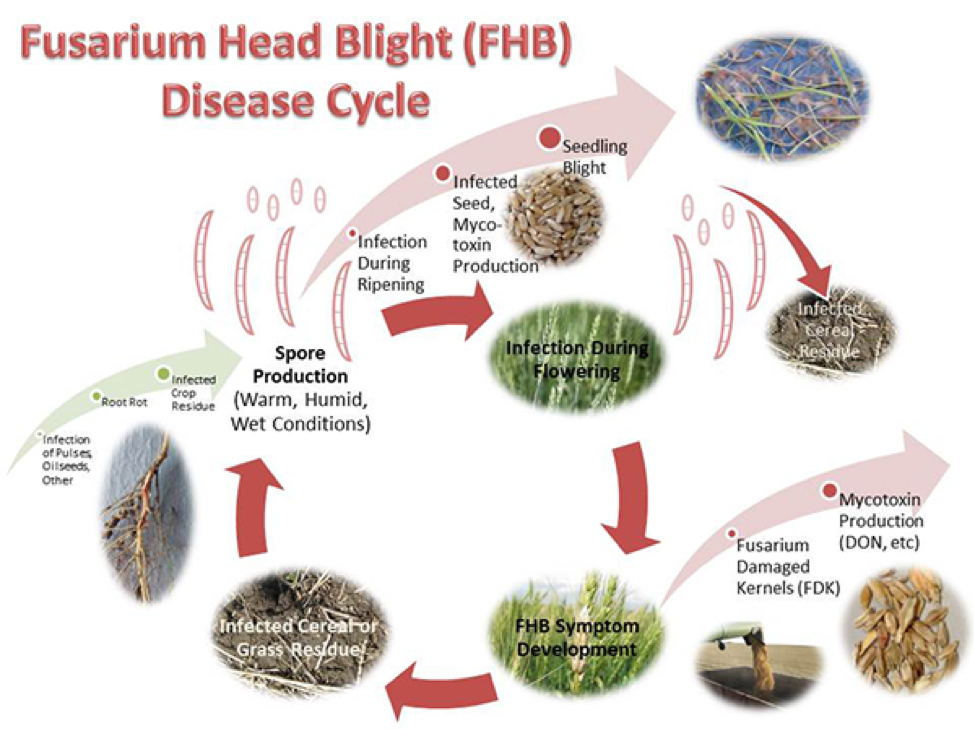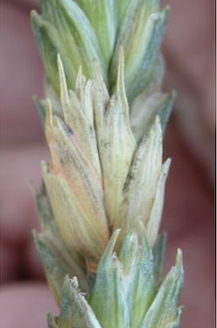Government mail service may be affected by the Canada Post labour disruption. Learn about how critical government mail will be handled.
Description
Fusarium head blight (FHB), also known as scab or tombstone, is a serious fungal disease of wheat (including durum), barley, oats and other small cereal grains and corn. It can also affect wild and tame grass species. However, the crops most affected are wheat, barley and corn.
FHB affects kernel development, reducing yield and grade. It can also contaminate grain with a fungal toxin (mycotoxin) produced in infected seeds. Infection of the harvested grain and/or mycotoxin production negatively affects:
- livestock feed
- baking and milling quality of wheat
- biofuel (ethanol) production
- malting and brewing qualities of malt barley
For detailed information on FHB and management practices for containing its spread, see: Fusarium Head Blight of Barley and Wheat
Cause
Fusarium head blight is caused by several species of the fungal genus Fusarium. Fusarium graminearum (F. graminearum or Fg) is the species that causes the most serious damage to crops. FHB is favoured by warm, humid conditions during flowering and early stages of kernel development.
Effect on livestock feed
FHB produces a mycotoxin called deoxynivalenol (DON), a poisonous compound that accumulates in the head (grain and chaff) of cereal crops. Little, if any, DON is present in the straw and leaves of the plant. Although different livestock species react differently to this mycotoxin, animals consuming high levels of DON may experience reduced feed intake, reduced immune response and reproductive dysfunction.
FHB-contaminated grain intended for livestock feed should be tested at a feed testing lab. Maximum tolerated levels of DON in livestock feed are 1 PPM for swine, dairy cattle and horses, and 5 PPM for beef cattle, sheep and poultry. For more information, see: Feeding Fusarium Contaminated Grain to Livestock.
Screening
The Canadian Grain Commission allows very little FHB (expressed as fusarium damaged kernels, i.e. FDK's) tolerances in the top grades of cereal grains. FHB-infected seed often reduces levels of germination and seedling vigour. For more information, see:
Fusarium head blight in western Canada
Identifying wheat and barley seed affected by fusarium head blight
Disease cycle
Figure 1. Fusarium head blight disease cycle

The pathogen causing FHB overwinters in crop debris/residues of small grain cereals and corn located on or in the soil. The pathogen can also cause root and crown rot of other crops such as pulses and oilseeds. It overwinters on all these infected residues, including infected seed that can re-infect an emerging seedling.
Warm, moist weather promotes spore formation on the infected crop residue, and the spores spread by wind to infect florets at the flowering stage of the cereal crop. A second, rain-splashed, spore stage can form on infected head tissue. Disease development accelerates when air temperatures around 25 degrees C are associated with precipitation, or very high humidity, for 36 hours.
While seedlings can become infected at emergence by planting infected seed, this usually causes seedling blight that does not necessarily lead to FHB or damage to kernels. However, this infected residue, resulting from seed-to-seedling transmission, allows the pathogen to overwinter on the field surface and may result in spore production and re-infection if a cereal is grown the following year.
Symptoms
The most common symptom of FHB is premature bleaching or blighting of heads. Visible symptoms can start to appear as soon as 3 weeks after floret infection.
FHB symptoms in wheat
Infected spikelets
FHB in wheat is recognized in the field by premature bleaching of one or more infected spikelets in the cereal plant’s head (Figure 1).
Figure 2. Cereal head with infected spikelet

Infected spikelets are visibly apparent on green heads during the early milk to hard dough stages (Figure 2).
Figure 3. FHB-infected wheat with bleached heads

Orangish/pinkish spore-bearing structures
Symptoms in wheat can include the production of orangish/pink, spore-bearing structures at the base of the glumes (Figure 3).
Figure 4. FHB infected wheat head

During wet weather, there may also be whitish, occasionally pinkish, fluffy fungal growth on infected heads in the field.
FHB symptoms in barley
Symptoms in barley are much less distinct. The brownish discolouration of FHB-infected barley spikelets can easily be confused with hail damage, or the extended symptoms of other barley diseases like spot blotch, kernel smudge, etc. (Figure 4).
Figure 5. Premature brown discolouration of FHB-infected spikelets in barley

Florets may have a pinkish or orange-ish appearance near their base or just beneath the glumes. The seeds in blighted heads do not fill properly and appear shrivelled and bleached.
See photos:
For more information on symptoms, see: Fusarium Head Blight of Barley and Wheat.
How it spreads
Fusarium graminearum produces 2 different fungal spore types, one that spreads via wind and another that spreads via splashing water droplets from rain or irrigation. Short distance spread occurs via the dispersal of fungal spores that are blown by the wind from one cereal field to the next or from plant to plant via water splashing. Long distance spread occurs through the transportation of infected crop residue or seed.
Outbreaks can be traced to several causes: widespread planting of highly susceptible varieties, existence of colonized residue from previous crops (especially with short rotations), presence of corn in rotations with small grains and weather favourable for infection.
Where it’s found
Fusarium head blight was first recognized as a fungal disease in North America in 1900. Repeated severe epidemics of FHB occurred from 1915 through the 1920s. The first report of FHB in Canada was in 1919. Again in the 1940s, FHB erupted in eastern Canada and the east-central USA. FHB was less frequently encountered during the 1950s, 60s and 70s, but in the early 80s, there were major outbreaks of the disease in eastern Canada, Manitoba and the US wheat states from North Dakota to Kansas. A severe outbreak in Manitoba in 1993 brought the problem to prominence in the Canadian Prairies.
Outbreaks of FHB in wheat or barley and other grains generally occur in the more humid regions of North America. Over the last several years, FHB has been the most serious cereal disease of the eastern Canadian Prairies, Eastern Canada, and the Midwest USA. In eastern Saskatchewan and Manitoba, Fusarium graminearum species is normally responsible for FHB.
Alberta situation
In Alberta, results regarding the occurrence of F. graminearum, based on testing by a range of private and public organizations using different methodologies and involving a range of plant tissues (for example, seed, heads, crowns, and nodes), have been consistent.
Until the last few years F. graminearum was either not detected, or infrequently detected in grain, seed and crop residues from central to northern Alberta. In contrast, F. graminearum was more frequently detected in grain, seed, cereal residues, corn residues, and head tissues from fields in southern Alberta, especially under irrigated production. However, over the period from 2001 to 2013 this pathogen was detected with increasing frequency, especially in southern Alberta.
Outside of southern Alberta during this period, other less damaging species of Fusarium were typically associated with FHB symptoms. However, since 2013, F. graminearum is more frequently detected in regions of Alberta outside of southern Alberta. For example, the number of counties in Alberta reporting F. graminearum in 2001 was nine, but the number jumped to 13, 22 and 26 in 2010, 2015 and 2016 respectively.
After extensive public consultation, the province developed the Alberta Fusarium graminearum Management Plan, which went into effect Oct. 1, 2002. The plan outlines beneficial management practices for meeting the threat of this disease, while still sustaining all sectors of the agriculture industry in Alberta.
Management
It is critical to use a combination of agronomic strategies to limit the introduction, escalation and spread of fusarium head blight in Alberta. Best management practices for FHB include the following:
- crop rotation
- variety selection
- use clean seed
- seed treatment
- increase seeding rate
- stagger planting dates between fields
- irrigation management
- fungicide application
- scout for symptoms
- harvest management (combine adjustment)
- harvest travel speed
- consider harvesting early
- post-harvest management
- storage aeration and drying
- separate storage
- gravity table and colour sorter
- control volunteers
- handling feed grain and grain spillage
- careful feed grain loading/unloading
- feed grain storage
- hay and straw management
For details on these management strategies, see: Fusarium head blight – Best management practices.
Lab testing
One of the foundational practices to prevent the spread of a seed-borne pest is to use disease-free seed. For this reason a laboratory certificate showing that seed was tested and found to be non-detectable for F. graminearum must accompany all cereal and corn intended for use as seed in Alberta.
Seed samples can be sent to the Canadian Grain Commission (CGC) or to a reputable private laboratory for testing. Several labs test for the general presence of any of the Fusarium species on seed, grass hay or cereal straw and the identification and differentiation of Fusarium species, including Fusarium graminearum, causing the infection. DON level in harvested grain can also be tested.
For information on lab testing through the CGC or private seed testing labs, see: Fusarium Head Blight of Barley and Wheat
Resources
Alberta Agriculture and Forestry
Alberta ‘Blue Book’ (Crop Protection manual)
Fusarium Head Blight of Barley and Wheat
Varieties of Cereal and Oilseed Crops for Alberta
Canadian Grain Commission
Fusarium Head Blight in Western Canada
Manitoba Agriculture, Food and Rural Initiatives
Dealing with Fusarium Head Blight
Fusarium Contaminated Grain to Livestock
Saskatchewan Agriculture and Food
Contact 310-FARM
Hours: 8:15 am to 4:30 pm (open Monday to Friday, closed statutory holidays)
Toll free: 310-FARM (3276) (in Alberta)
Phone: 403-742-7901 (outside Alberta)
Email: [email protected]